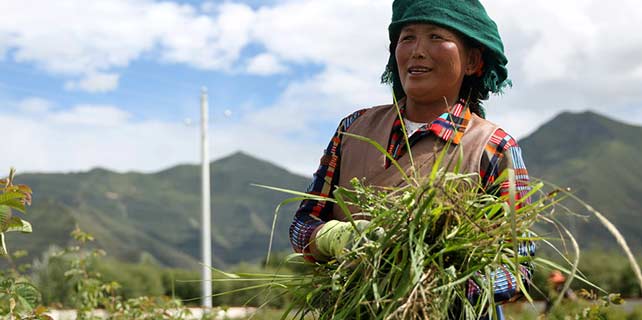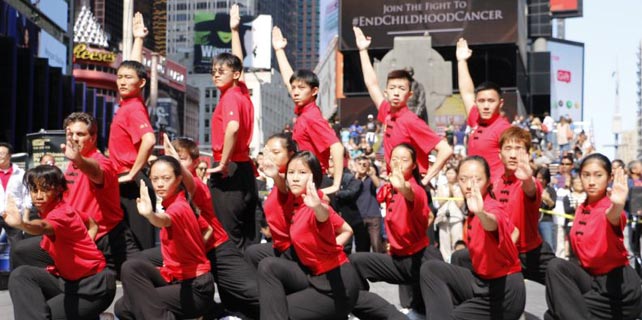Dance drama The Red Sorghum builds bridges across cultures
Gracie Li holds her breath, eyes wide open, as she follows the intense plots on Friday night of The Red Sorghum, a dance drama adapted from Nobel Prize laureate Mo Yan's 1986 novel and brought to the US by the Qingdao Song and Dance Theatre from Shandong province.
The American-born Chinese teenager periodically turned to her mom, a Beijing immigrant who accompanied her to the show, checking foreshadowing and episode developments in order to truly understand the scenic yet violent melodrama. The novel depicts the lives of a group of townspeople in Shandong who fiercely fought Japanese invasions in the 1930s. It also follows their intertwined romances.
"I love this drama. I want to read the original novel," said Li, 13, admitting her current Chinese-language proficiency won't enable her to do so. "My mom insists that I should keep learning Chinese so I will know more about Chinese culture."
Joining Li on Sept 8 were approximately 1,100 audience members from all walks of life in the San Francisco Bay Area, said Xiao Xiayong, cultural consul at the Chinese Consulate General in San Francisco, who helped orchestrate Red Sorghum's maiden performance in the US.
The dance serves as a prelude to a series of cultural exchanges such as exhibitions on Chinese paintings in Seattle, an intangible cultural heritage display in Las Vegas, and seminars on Confucius in San Francisco and Sacramento, said Xiao, adding that they are sponsored by the Shandong Provincial Department of Culture in the name of Shandong Culture Week.
Due to the favorable geographical, political and people-to-people exchange conditions, all states in the consulate general's territory – California, Washington, Oregon, Nevada and Alaska — show an increasingly strong interest in launching more cultural collaborations with China, said Xiao, who has been overseeing China-US cultural co-operations for more than three years.
Since the two governments adopted the annual US-China Consultation on People-to-People Exchange mechanism in 2010, the world's two largest economies have continued to deepen ties between citizens in the areas of culture, education, science and technology, sports, women's issues and health.
Cultural and educational exchange programs between China and the US are important, but are really still in the developmental stages. There is a discrepancy between Chinese familiarity with US culture and Americans' lack of Chinese knowledge.
"We ordinary Chinese people might know many Hollywood movies, Broadway musicals and American pop music," said Xiao. "I doubt the US general public has mastered the same amount of Chinese cultural information."
To bridge the gap, both governments have encouraged non-governmental organizations such as universities, museums, foundations, sports groups and cultural institutions to join the chorus and establish a broad spectrum of exchange programs.
In California, "we rely on overseas Chinese to promote Chinese culture and have reached out to many mainstream organizations for collaborations," said Xiao, who added that celebrations of the Chinese New Year have been observed at venues such as the Facebook campus, public libraries, schools and universities, as well as the NBA's Golden State Warriors' arena.
"We've executed 36 projects through our platform of the Across the Pacific China Arts Festival, which is in its fourth consecutive year, and tried to engage American people through a variety of activities including exhibitions, film festivals, seminars and performances," Xiao said. "We not only have showcased splendid Chinese culture but cemented the China-US relationship through the culture medium."
Xiaopei He Gelb, the director of Huaxing Arts Group San Francisco and a renowned dancer herself, said the mission of her troupe, which was established last year, is to help introduce Chinese art and culture to American society.
"China has a history of 5,000 years. Its culture and civilization are sophisticated and comprehensive, which benefits the entire world," He said. "We Chinese artists have the responsibility to spread its influence."
He, together with local Chinese artists in San Francisco, organized the Red Sorghum show. "Since day one, I'm dealing with two very different systems and industry regulations that created many difficult problems," she said. "I stayed up late Thursday night to make sure the stage installation would be completed in time."
Her efforts paid off.
Emily Ma, 11, told her mom that she would like to learn Chinese culture through watching performances like Red Sorghum.
"Amazing!" the American-born Chinese girl said. "It's much more fun than sitting in a Chinese school and studying Chinese."
Contact the writer at junechang@chinadailyusa.com
















